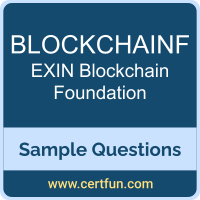 The purpose of this Sample Question Set is to provide you with information about the EXIN Blockchain Foundation (BLOCKCHAINF) exam. These sample questions will make you very familiar with both the type and the difficulty level of the questions on the BLOCKCHAINF certification test. To get familiar with real exam environment, we suggest you try our Sample EXIN Blockchain Foundation Certification Practice Exam. This sample practice exam gives you the feeling of reality and is a clue to the questions asked in the actual EXIN Blockchain Foundation certification exam.
The purpose of this Sample Question Set is to provide you with information about the EXIN Blockchain Foundation (BLOCKCHAINF) exam. These sample questions will make you very familiar with both the type and the difficulty level of the questions on the BLOCKCHAINF certification test. To get familiar with real exam environment, we suggest you try our Sample EXIN Blockchain Foundation Certification Practice Exam. This sample practice exam gives you the feeling of reality and is a clue to the questions asked in the actual EXIN Blockchain Foundation certification exam.
These sample questions are simple and basic questions that represent likeness to the real EXIN Blockchain Foundation exam questions. To assess your readiness and performance with real-time scenario based questions, we suggest you prepare with our Premium EXIN BLOCKCHAINF Certification Practice Exam. When you solve real time scenario based questions practically, you come across many difficulties that give you an opportunity to improve.
EXIN BLOCKCHAINF Sample Questions:
01. What is an advantage of using the consensus algorithm Proof of Elapsed Time (PoET) instead of Proof of Work (PoW)?
a) PoET is usually faster than PoW, because fewer nodes compete for validation than in PoW, since PoET randomly selects the nodes.
b) PoET has generally lower transaction costs than PoW, because the hardware needed is more generic than the hardware needed for PoW.
c) PoET is much more secure than PoW, because PoET supports the trusted execution environment (TEE) by time-stamping the transactions.
d) PoET can often be used in a permissionless blockchain more easily than PoW, because PoET’s lottery system for node selection is secure.
02. Blockchain technology has made decentralized marketplaces possible. What is a benefit of a decentralized marketplace?
a) It is based on open-source technology, so it can be used without any investment.
b) It is not under a paid license to operate and therefore it is managed better.
c) It is relatively cheap due to the use of cryptocurrency and is very accessible.
d) It is tamper-proof, resilient to being shut down and trustworthy due to smart contracts.
03. Public blockchains give an incentive to encourage users to mine blocks and secure the network. What incentive is this?
a) Public blockchains allow users to create tokens to sell on secondary markets.
b) Public blockchains do not offer rewards, because they are open source.
c) Public blockchains offer rewards for mining in the form of cryptocurrency.
d) Public blockchains offer cash rewards for running mining nodes.
04. A bearer instrument used to transfer value between two parties over a blockchain network. What is this instrument?
a) A DApp
b) A token
c) A node
d) A hash
05. What is an example of the use of cryptography in a blockchain?
a) Accessing private or hybrid blockchains by using a private key
b) Creating cryptocurrency as a reward for mining nodes
c) Keeping blockchains secure from 51% attacks by corrupt nodes
d) Securing transfers of cryptocurrency between recipients
06. One of the greatest threats to the blockchain community is the narcissism of small differences. What is the result of this narcissism of small differences?
a) One community group makes fun of another community group over small differences, resulting in greater collaboration.
b) The community cares about and works to resolve small differences that cannot be perceived by outside groups.
c) The community has developed many similar projects and these fight with one another over small differences.
d) The community has grown closer and works together in a collaborative fashion to solve common problems.
07. Why is blockchain described as the technology that adds a layer of trust to the internet?
a) It allows individuals and groups to work together without having to trust each other or establish authority.
b) It creates a dedicated virtual private network (VPN) tunnel between two or more parties to carry out online fund transfers.
c) It provides mechanism for the government to create their own digital fiat currency as a replacement of physical currency.
d) It provides multifactor authentication to create and update records of cryptocurrency transactions securely.
08. How does blockchain technology help to protect intellectual property rights (IP)?
a) It allows a user to include IP transactions in smart contracts.
b) It allows a user to record an event and establish the timeline.
c) It allows a user to record the creation of software packages.
d) It allows a user to send a transaction and receive IP ownership.
09. The Monetary Authority of Singapore (MAS) and blockchain company R3 partnered together. What did they achieve together?
a) The creation of smart contracts and stable coins
b) The facilitation of interbank transmission of messages
c) The first interbank payments without limitations of time zones
d) The launch of wire transfers using cryptography
10. A competitive consensus algorithm that was developed because blockchains had difficulty meeting the transaction speed demands. Which consensus algorithm is this?
a) Proof of Stake (PoS)
b) Proof of Burn
c) Delegated Proof of Stake (DPoS)
d) Proof of Work (PoW)
Answers:
|
Question: 01 Answer: a |
Question: 02 Answer: d |
Question: 03 Answer: c |
Question: 04 Answer: b |
Question: 05 Answer: d |
|
Question: 06 Answer: c |
Question: 07 Answer: a |
Question: 08 Answer: b |
Question: 09 Answer: c |
Question: 10 Answer: a |
Note: For any error in EXIN Blockchain Foundation certification exam sample questions, please update us by writing an email on feedback@certfun.com.
